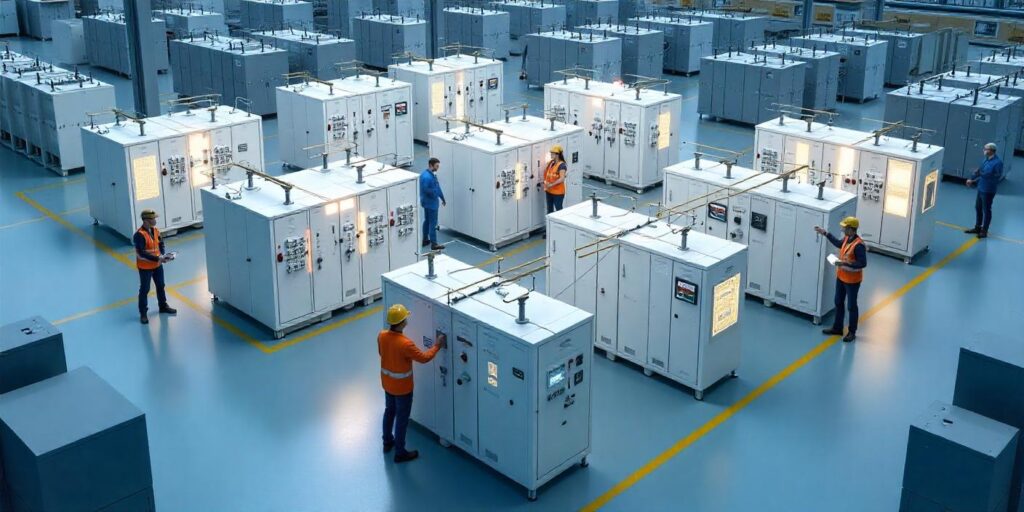Introduction:
As industries continue to evolve in response to technological advancements and market demands, the need for flexible and scalable solutions in power distribution becomes increasingly important. Modular Switch Rooms (MSRs) stand out as a prime example of how innovative design can address these challenges. By leveraging a modular design approach, MSRs enable organizations to adapt their power distribution systems with ease, allowing for quick reconfiguration and scalability as operational needs change.
This blog explores the flexibility and scalability features of Modular Switch Rooms, highlighting how they support dynamic business environments and contribute to operational efficiency.
Understanding the Need for Flexibility and Scalability
In today’s fast-paced industrial landscape, businesses face the challenge of rapidly changing operational requirements. Factors influencing this need include:
- Technological Advancements: As new technologies emerge, organizations must integrate them into their operations, requiring flexible power distribution solutions that can accommodate new equipment and systems.
- Business Growth: As companies expand, their energy needs increase. Scalable power distribution systems allow for easy adjustments to meet growing demands without extensive downtime or reengineering.
- Regulatory Changes: Industries must comply with evolving regulations, which may necessitate modifications to existing systems. Flexible designs enable quick adaptations to meet new compliance standards.
The Modular Design of Switch Rooms
The core principle behind Modular Switch Rooms is their modular design, which offers numerous advantages in terms of flexibility and scalability:
- Prefabricated Units: Modular Switch Rooms are prefabricated off-site and delivered as complete units. This approach reduces installation time and costs while ensuring high-quality construction. The ability to deploy prefabricated units allows for rapid response to changing energy needs.
- Customizable Layouts: Each Modular Switch Room can be customized to suit specific requirements. Organizations can choose the configuration, size, and features that align with their operational needs. This customization ensures that power distribution systems are tailored to individual business demands.
- Easy Reconfiguration: Modular designs allow for straightforward reconfiguration when operational needs change. If a facility expands or if new equipment is added, Modular Switch Rooms can be easily modified without major overhauls. This flexibility helps organizations adapt quickly to evolving requirements.
- Scalability: As businesses grow, Modular Switch Rooms can be easily scaled up to accommodate increased power demands. Additional modules can be added without disrupting existing operations, ensuring continuity and reliability in power distribution.
Advantages of Flexibility and Scalability in Modular Switch Rooms
The benefits of flexibility and scalability in Modular Switch Rooms are substantial, impacting various aspects of organizational performance:
- Reduced Downtime: With the ability to quickly reconfigure and scale power distribution systems, organizations can minimize downtime during transitions. This is especially critical in industries where continuous operations are vital.
- Cost-Effective Solutions: Modular Switch Rooms provide a cost-effective way to meet changing energy demands. Rather than investing in entirely new systems, businesses can expand their existing infrastructure, optimizing their capital expenditures.
- Future-Proofing: As industries evolve, Modular Switch Rooms offer a future-proof solution. Their flexible designs can accommodate new technologies, allowing organizations to stay ahead of the curve without extensive redesigns.
- Enhanced Operational Efficiency: By enabling quick adaptations to changing requirements, Modular Switch Rooms enhance overall operational efficiency. Organizations can optimize their power distribution systems based on real-time needs, ensuring maximum performance.
- Sustainability: The modular design approach contributes to sustainability efforts. By allowing for incremental expansions and modifications, organizations can minimize waste associated with outdated systems and equipment.
Implementing Flexible and Scalable Modular Switch Rooms
To maximize the benefits of flexibility and scalability, organizations should consider the following steps:
- Assess Current and Future Needs: Conduct an assessment of current power distribution needs and anticipate future requirements to determine the appropriate modular design and features.
- Choose the Right Technology: Select Modular Switch Rooms that incorporate advanced technologies for monitoring and control, enabling seamless adjustments and scalability.
- Plan for Future Growth: Design power distribution systems with future growth in mind, ensuring that Modular Switch Rooms can be easily expanded or reconfigured as needed.
- Train Personnel: Ensure that staff members are trained to understand the modular systems and how to effectively manage reconfigurations. Empowering employees with knowledge enhances operational efficiency.
Conclusion:
Flexibility and scalability are critical components of modern power distribution systems, and Modular Switch Rooms excel in delivering these advantages. With their modular design, customizable layouts, and easy reconfiguration, MSRs empower organizations to adapt swiftly to changing operational demands.
By investing in Modular Switch Rooms, businesses can reduce downtime, enhance operational efficiency, and future-proof their power distribution systems. As industries continue to navigate evolving challenges, the ability to flexibly scale power distribution solutions will be vital for maintaining a competitive edge.
Organizations looking to embrace a dynamic and responsive approach to power distribution should consider integrating Modular Switch Rooms into their infrastructure, paving the way for improved efficiency and adaptability.







